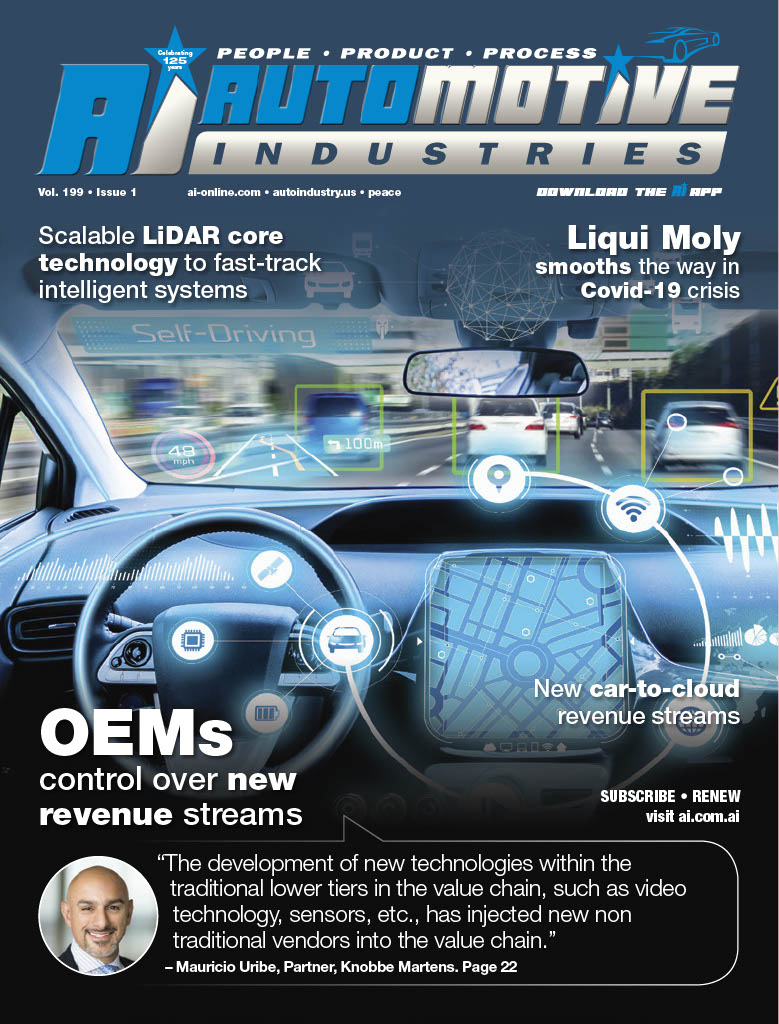
Among the most serious challenges facing OEMs is ensuring that they have control over the new revenue streams being created by the penetration of the industry by non-traditional suppliers.

These suppliers often compete directly with the OEMs for the new revenue streams opened up by connected car technology. This is one of the factors behind double-digit year-on-year growth in the number of patent filings around the world by the automotive industry over the past five years. While Google has dominated headlines in self-driving cars, Toyota, GM and Hyundai received the most patents in this area, according to a report by Thomson Reuters IP & Science.
South Korean automaker Hyundai Motor posted the biggest gains in the number of patent filings during the survey period, narrowing the gap with industry leader Toyota. The survey analyzed patent applications and mapped trends in five key areas: Propulsion, navigation, handling, safety and security, and entertainment.
One of the leaders in the emerging field of connected car technologies intellectual property (IP) rights is Knobbe Martens, which is among the largest intellectual property and technology law firms in the United States. Partner Mauricio Uribe is a recognized authority in connected car technologies’ IP issues. He has been the keynote speaker at a number of automotive IP conferences around the world.
He says the traditional model of voluntary standards organizations (SSOs) setting shared technical specifications and standards to help eliminate the cost of switching platforms for consumers has been found to have weaknesses within the changing nature of the automotive industry. While most standard setting organizations establish IP policy, they do not evaluate the essential nature of “declared” patents nor specify licensing terms.
“Most IP policies require a declaration of essential patents for organizations contributing to the standards. Declared patents typically require a contractual commitment to the SSO to offer FRAND (fair, reasonable and non-discriminatory) license terms. Most jurisdictions acknowledge third-party rights to enforce FRAND commitment and most jurisdictions require FRAND commitment to ‘run’ with the patent against subsequent purchasers,” says Uribe.
“If a patented technology is adopted by a SSO, patent holdup refers to potential economic gain to the patent holder not from the value of the patented technology, but by the high cost or impossibility of avoiding the patented technology with a technology not adopted in the standards. SSO IP Policy requires an active declaration policy to prevent delayed declaration of essential IP after incorporation into standards,” he adds.
Uribe provides counsel on patentability, due diligence and infringement mitigation matters and comprehensive intellectual property programs including litigation and global patent and technology licensing. He has also been very active in the prosecution of patent applications in both the electrical engineering and computer software fields for more than 15 years.
Automotive Industries (AI) asked Uribe what type of intellectual property issues face companies in the connected vehicle marketplace.
Uribe: The automotive industry is well-versed and sophisticated in terms of not only how companies develop complex, global patent portfolios, but also in how intellectual property can be enforced to be monetized or to influence market share. Traditionally, the organization of the automotive manufacturing industry into an organized hierarchy of OEMs/manufacturers and tiered suppliers (e.g., Tier 1 suppliers, Tier 2 suppliers, etc.) lent itself to the perception of hesitancy for industry participants to engage in widespread patent assertions and counter-assertions.
More specifically, because the same supplier or set of suppliers provided mechanical components to multiple OEMs, business relationships between the tiered suppliers and the manufacturers often de incentivized patent assertions in the marketplace.
But, the automotive industry has been modified by the dilution of the traditional tiered supplier value chain through the incorporation of additional technologies (e.g., connected vehicle technologies) and the inclusion of additional, nontraditional vendors/suppliers. This has provided the greatest change in terms of the assertion of patents within portions of the automotive marketplace.
More specifically, the development of new technologies within the traditional lower tiers in the value chain, such as video technology, sensors, etc., has injected new non traditional vendors into the value chain. These suppliers often do not adhere to the same patent litigation resistant strategies that were established in the automotive industry. Moreover, many of these technologies, such as video compression technology or short-range wireless communication, are already associated with higher levels of patent assertions, such as non-practicing patent assertion entities. This results in an almost immediate exposure of the automotive industry to “external” patent threats simply by virtue of adoption of such technologies.
AI: You speak about standard essential patents being required in the connected car ecosphere – please explain.
Uribe: Many of the technologies associated with the connected vehicle value chain correspond to standardized technologies, such as short-range wireless communication (e.g., Wi-Fi), cellular communication, image compression, etc. By its definition and to achieve interoperability, manufacturers providing products/services compliant with such technical standards must adhere to certain technical standards. For a standard to be considered “essential”, the patent is necessarily infringed by any entity implementing (or being compliant with) it. Thus, to the extent connected vehicle solutions leverage standardized technologies, licenses to corresponding SEP (standard essential patent) patents would be necessary.
AI: How effective have SEPs been so far?
Uribe: SEPs and IP policies related to licensing SEPS (e.g., FRAND licensing obligations) are designed to facilitate the widespread adoption of technical standards to achieve interoperability. These policies also represent the balance in rewarding patent holders for the innovation embodied in the issued patents and ensuring that willing licensees are not required to overpay license fees simply because a technological solution forms a part of a technical standard. Accordingly, effectiveness of SEPS can be measured based on these two considerations (e.g., widespread adoption and widespread licensing).
AI: How do IP issues differ across the automotive value chain?
Uribe: One of the primary differences in IP across the value chain relates primarily to the royalty basis charged by the patent holders. As an example, assume there is a set of SEPs related to functionality implemented on a chipset found in a connected vehicle. As applied to a Tier 1 or Tier 2 supplier that may supply the chipset or integrated component including the chipset to a vehicle manufacturer, the royalty basis for an SEP license would appropriately correspond to the chipset/integrated component. However, for the vehicle manufacturer, the royalty basis for an SEP license could be the same chipset/integrated component or the connected vehicle itself. Having a connected vehicle as the royalty basis for SEP licenses represents a potential for greater licensing revenue for SEP holders. Accordingly, SEP holders are incentivized to seek licenses from OEMs and avoid licensing the Tier 1 or Tier 2 vendors that are associated with the smaller royalty basis. This very issue is currently the subject of litigation in both Europe and the United States.
AI: Hyundai is reported to have found that it was lagging behind in filing patents. Has this been an issue for automotive manufacturers as far as connected car technologies are concerned?
Uribe: I cannot comment as to the specifics of Hyundai (or any other manufacturer). However, in general, many OEMs implementing new technologies associated with connected vehicles rely heavily on third-party vendors that are not traditional Tier 1 or Tier 2 vendors. Such OEMs have little need or incentive to develop expertise in these technologies because they represent “black box” technologies that can implemented/integrated directly into a connected vehicle. While this has the advantages related to product/feature development costs, it also has the effect that OEMs often struggle to develop IP assets related to the new technologies and may be more limited in leveraging “homegrown” patents during license negotiations.













More Stories
Cybord TCI – The Future of Manufacturing Integrity
Getac on AI’s transformative impact on automotive production and aftersales
New Infineon Bluetooth range designed to meet OEM needs